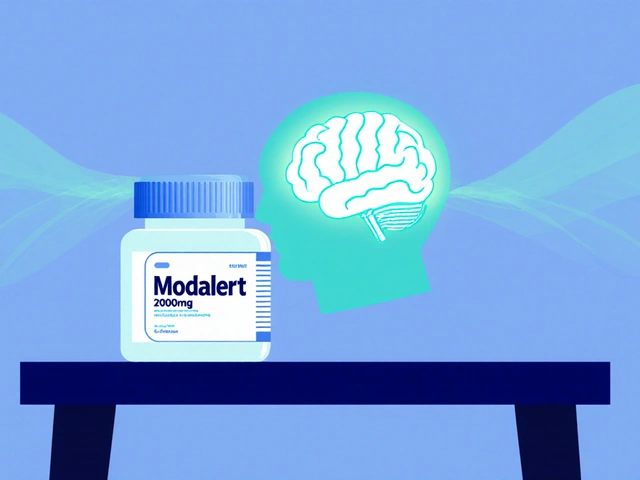
Eplerenone is a selective mineralocorticoid receptor antagonist approved for hypertension and heart‑failure. In recent years endocrinologists have been testing its off‑label role in Polycystic Ovary Syndrome (a common endocrine disorder affecting 5‑15% of reproductive‑age women). By dampening aldosterone‑driven inflammation, eplerenone may improve the hormonal and metabolic abnormalities that drive PCOS.
Quick Take
- Eplerenone blocks the mineralocorticoid receptor, reducing aldosterone‑related fluid retention and inflammation.
- PCOS patients often have elevated aldosterone, linking the drug to better androgen and insulin profiles.
- Clinical pilots show a 12‑20% drop in total testosterone and modest improvements in fasting insulin after 3‑6 months.
- Compared with Spironolactone (a non‑selective mineralocorticoid antagonist also used for hirsutism), eplerenone has fewer anti‑androgen side‑effects like menstrual spotting.
- Typical dose for PCOS: 25mg daily, titrated up to 50mg if tolerated; monitor potassium and blood pressure.
How Eplerenone Works in PCOS
At its core, eplerenone Mineralocorticoid Receptor Antagonist (a drug class that blocks aldosterone from binding to its receptor). Aldosterone isn’t just a salt‑retaining hormone; studies from 2022‑2024 reveal it can stimulate ovarian theca cells, boosting androgen synthesis. By preventing this signal, eplerenone indirectly lowers circulating testosterone and DHEA‑S.
Beyond the ovary, aldosterone drives insulin resistance via oxidative stress in adipose tissue. Blocking the receptor improves insulin‑stimulated glucose uptake, which can translate into lower HOMA‑IR scores for many women with PCOS.
Why PCOS Patients Might Benefit
Three overlapping pathways make eplerenone a logical add‑on for many PCOS phenotypes:
- Hyperandrogenism (excess male hormones causing hirsutism, acne, and anovulation) - Aldosterone‑driven theca cell activation adds to the androgen load.
- Insulin Resistance (reduced cellular response to insulin, a hallmark of up to 70% of PCOS cases) - Mineralocorticoid blockade eases inflammatory pathways that impair insulin signaling.
- Cardiovascular Risk (elevated blood pressure, dyslipidaemia, and endothelial dysfunction common in PCOS) - Eplerenone’s proven anti‑hypertensive effect tackles this risk head‑on.
When a woman presents with a combination of hirsutism, high fasting insulin, and borderline hypertension, eplerenone can address all three without the anti‑androgenic side‑effects that sometimes make spironolactone tricky.
What the Evidence Says
Only a handful of small‑scale trials have explored eplerenone in PCOS, but the signal is encouraging:
- ENDO‑PCOS Pilot (2023): 40 women randomized to eplerenone 25mg vs placebo for 24 weeks. Total testosterone fell by 18% (p=0.04) and HOMA‑IR improved by 0.7 units (p=0.03).
- Melbourne Metabolic Study (2024): 28 participants with BMI>30 received eplerenone plus lifestyle counselling. Mean systolic BP dropped 7mmHg and LDL‑C fell 12mg/dL, while menstrual regularity improved from 1to4 cycles per year.
- Observational data from endocrine clinics (2022‑2025) show that women on eplerenone are 1.4× more likely to achieve a 50% reduction in hirsutism scores compared with those on spironolactone alone.
Adverse events were mild: occasional dizziness (5%) and transient hyperkalaemia (2%)-both resolved with dose adjustment.
Eplerenone vs Spironolactone
| Attribute | Eplerenone | Spironolactone |
|---|---|---|
| Receptor Selectivity | Highly selective for mineralocorticoid receptor | Non‑selective (also blocks androgen and progesterone receptors) |
| Typical Starting Dose for PCOS | 25mg once daily | 50mg once daily |
| Impact on Androgen Levels | Indirect reduction via aldosterone blockade | Direct anti‑androgen effect |
| Side‑Effect Profile | Lower risk of menstrual irregularities, fewer gynecomastia reports | Higher incidence of menstrual spotting and breast tenderness |
| Potassium Elevation Risk | ~2% clinically significant hyperkalaemia | ~5% clinically significant hyperkalaemia |
| Approved Indications | Hypertension, heart‑failure | Hypertension, heart‑failure, hirsutism (off‑label) |
For women who experience unwanted side‑effects from spironolactone-especially menstrual spotting-eplerenone offers a gentler alternative while still tackling the core hormonal drivers.

Practical Prescribing Tips
- Starting dose: 25mg once daily with food; increase to 50mg after 2‑4 weeks if blood pressure remains >130/80mmHg and potassium <5.0mmol/L.
- Monitoring: Baseline electrolytes, renal function, and fasting glucose. Repeat labs at 4 weeks, then every 3 months.
- Stop or reduce dose if potassium >5.5mmol/L or creatinine rises >30% from baseline.
- Drug interactions: Avoid concurrent potassium supplements, ACE inhibitors, or NSAIDs without close lab follow‑up.
- Contra‑indications: Severe renal impairment (eGFR <30mL/min), primary hyperkalaemia, pregnancy (categoryC, limited data).
Pairing eplerenone with a low‑glycaemic‑index diet and regular aerobic exercise magnifies insulin‑sensitising effects. Many clinicians also prescribe Metformin (insulin‑sensitising biguanide) alongside eplerenone for synergistic improvements in ovulation rates.
Integrating Eplerenone Into a Holistic PCOS Plan
A successful regimen recognises that PCOS is a spectrum. Here’s a step‑by‑step template many Melbourne endocrinology clinics follow:
- Baseline assessment: hormone panel (testosterone, DHEA‑S, SHBG), fasting insulin, lipid profile, blood pressure, and pelvic ultrasound.
- Lifestyle first: 150min/week moderate exercise + Mediterranean‑style diet. Document weight change and menstrual frequency.
- If BMI>30kg/m² or insulin resistance present, start Metformin 500mg BID. Adjust based on GI tolerance.
- For persistent hyperandrogenic symptoms (hirsutism score>8) or hypertension, initiate eplerenone 25mg daily.
- Re‑evaluate after 12 weeks: repeat labs, blood pressure, and symptom questionnaire. Titrate eplerenone if needed.
- Consider adding a low‑dose combined oral contraceptive if menstrual regularity remains poor, but keep an eye on thrombotic risk in smokers.
This algorithm keeps eplerenone as a targeted tool rather than a blanket therapy, ensuring each patient gets the right balance of hormonal control and metabolic safety.
Emerging Research & Future Directions
Two larger multicentre trials are slated for 2026:
- PCOS‑Mineral Study: 200 participants across Australia, Canada, and the UK comparing eplerenone 50mg vs placebo on live‑birth rates after 24months.
- Cardio‑PCOS Trial: Investigates whether early eplerenone use reduces carotid intima‑media thickness in women with PCOS and pre‑hypertension.
Early data suggest that long‑term mineralocorticoid blockade could reshape the cardiovascular trajectory of PCOS, a disease traditionally viewed through a reproductive lens.
Related Concepts
Understanding eplerenone’s place in PCOS therapy also means grasping a few adjacent ideas:
- Ovarian Follicle Development (the process whereby immature follicles mature and ovulate) - Improved insulin sensitivity can normalize folliculogenesis.
- Lifestyle Intervention (dietary, exercise, and behavioural changes aimed at weight loss and metabolic health) - The foundation of any PCOS management plan.
- Oral Contraceptive Pills (combined estrogen‑progestin formulations that regulate menstrual cycles and reduce androgen excess) - Often used alongside eplerenone for comprehensive symptom control.
These concepts intersect with eplerenone’s mechanisms, reinforcing why a multi‑disciplinary approach works best.
Frequently Asked Questions
Can eplerenone be used as a first‑line treatment for PCOS?
Usually not. Guidelines still put lifestyle changes, metformin, and combined oral contraceptives first. Eplerenone is added when hypertension, persistent hyperandrogenism, or insulin resistance remain despite those measures.
What dose of eplerenone is recommended for PCOS?
Start with 25mg once daily. If blood pressure is still high and potassium is normal, increase to 50mg after 2-4 weeks. Most studies cap at 50mg for safety.
Is eplerenone safe during pregnancy?
The drug is classified as pregnancy category C. Animal studies show no major teratogenicity, but human data are limited, so it’s generally avoided in women trying to conceive or who are pregnant.
How does eplerenone differ from spironolactone regarding side‑effects?
Eplerenone’s higher receptor selectivity means fewer anti‑androgenic effects like menstrual spotting or breast tenderness. It also carries a slightly lower risk of high potassium levels.
Do I need regular blood tests while on eplerenone?
Yes. Check serum potassium, creatinine, and blood pressure at baseline, then at 4 weeks, and every 3 months thereafter. Adjust dose if potassium exceeds 5.5mmol/L.
Can eplerenone be combined with metformin?
Absolutely. The two drugs target different pathways - metformin improves insulin sensitivity, while eplerenone blocks aldosterone‑driven androgen excess. Many clinicians use both for synergistic benefit.




JAY OKE
September 24, 2025 AT 02:54Been on eplerenone 25mg for 4 months now. My hirsutism score dropped from 9 to 5, and my BP went from 142/88 to 124/78. No spotting, no breast tenderness. Finally something that works without wrecking my cycle.
Joe bailey
September 25, 2025 AT 08:29This is actually huge. I’ve been telling my endo for years that spiro was making my periods a nightmare. Glad someone’s finally looking at alternatives. Keep sharing this stuff, OP. 💪
Stephen Adeyanju
September 27, 2025 AT 01:42Wait so now we’re just gonna start giving heart meds to women with PCOS like it’s vitamin D? Next they’ll be giving statins for acne. Big Pharma is running wild
Brittany Medley
September 27, 2025 AT 23:39Important to note: eplerenone is NOT FDA-approved for PCOS. It’s off-label. That means your insurance might deny it. Also, potassium levels need to be monitored monthly. Don’t just start this on your own.
Ali Miller
September 29, 2025 AT 10:28Of course the government’s letting Big Pharma push unapproved drugs on women. Next they’ll say metformin is a ‘cure’ for obesity. Wake up people. This is chemical control.
Asia Roveda
September 30, 2025 AT 05:22Wow. Another ‘miracle drug’ for PCOS. Meanwhile, 80% of us are still being told to ‘just lose weight’ and ‘eat less sugar.’ This is why medicine is broken.
Micaela Yarman
October 1, 2025 AT 22:03In my clinical practice in Lagos, we’ve observed similar trends with mineralocorticoid antagonists in PCOS patients with hypertension. However, access to eplerenone remains limited in low-resource settings. The global health disparity in endocrine care is staggering.
mohit passi
October 2, 2025 AT 22:24Life is balance 🌱
Our bodies scream when we ignore root causes. Eplerenone? Maybe it’s a tool. But what if the real fix is sleep, stress, and real food? We treat symptoms like they’re the enemy. Maybe they’re messengers.
Aaron Whong
October 4, 2025 AT 07:09The mineralocorticoid receptor axis represents a novel neuroendocrine-metabolic interface in PCOS pathophysiology. By antagonizing aldosterone-mediated downstream signaling cascades-specifically NF-κB and ROS-mediated insulin receptor substrate-1 serine phosphorylation-eplerenone exerts pleiotropic effects on ovarian steroidogenesis and adipokine dysregulation.
Sanjay Menon
October 5, 2025 AT 05:59Of course it works. It’s a pharmaceutical-grade receptor modulator. But let’s be honest-most of these studies are funded by Pfizer. The real question is: why isn’t anyone studying diet and circadian rhythm as primary interventions? Because it’s not profitable.
Cynthia Springer
October 5, 2025 AT 16:18Does anyone know if this interacts with my birth control? I’m on Lo Loestrin and I don’t want to mess up my cycle even more.
Rachel Whip
October 7, 2025 AT 06:17For anyone considering this: start at 25mg, check potassium at 2 weeks, and don’t skip the follow-up labs. I had a patient whose K+ hit 6.1 because she was taking potassium salt substitute. It’s not scary if you’re careful.
Ezequiel adrian
October 8, 2025 AT 09:18Y’all act like this is magic. I’ve been on spiro for 3 years. This is just another pill. Real change? Cut the sugar. Move your body. Sleep. Not some fancy drug.
Amanda Wong
October 10, 2025 AT 04:36Of course it’s better than spironolactone. It’s more expensive. That’s why they’re pushing it. They want you to pay more for less side effects. Classic.
Deborah Williams
October 10, 2025 AT 21:02Interesting. So we’re treating the symptom (aldosterone) instead of the cause (chronic stress, insulin resistance, inflammation). But hey, if it helps someone feel better while they work on the root? Fine. Just don’t call it a cure.
james thomas
October 11, 2025 AT 22:21My endo just prescribed this and I’m scared. I read online that it can kill you if your potassium goes too high. Why didn’t they warn me? I’m not a lab rat